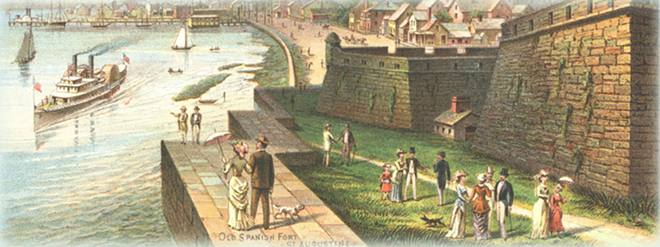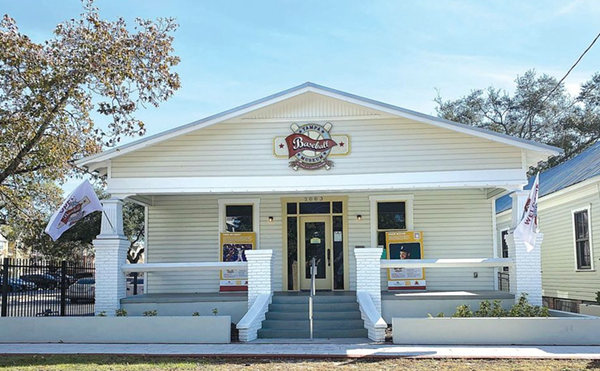
St. Augustine at 450:
A Look at the Oldest European City in the U.S.
The Tampa Bay History Center is commemorating the 450th anniversary of the founding of St. Augustine, the oldest continuously occupied European settlement in North America, with an exhibit St. Augustine cultural history, original maps, as well as artifacts. Through Oct. 31.
Hours are 10 a.m.-5 p.m. daily. 801 Old Water St., Tampa.
tampabayhistorycenter.org/exhibits/temporary-exhibits.
This year marks the 450th anniversary of the founding of St. Augustine, the oldest continuously occupied European settlement in North America. In commemoration, the Tampa Bay History Center is mounting St. Augustine at 450: A Look at the Oldest European City in the U.S., a small exhibit of maps, engravings and artifacts from the past four centuries. Even nearly five centuries later, unearthed documents are revealing more about the historic community.
The maps, from the Tom and Lee Touchton Collection of Maps and Ephemera, represent a rare opportunity, in this satellite-circumnavigated world, to glimpse the strange geographic imaginings of the past. More broadly, the engravings and photos are windows into St. Augustine’s strange dark story.
In the mid-1500s, a group of French Huguenots settled in what is now Jacksonville, then already formally held by the Spanish. The Huguenots, not content with simply being French, were also protestants, influenced by John Calvin. Though these were not specifically religious refugees, Huguenots were not generally welcome in France, and settling a new land was probably a smart move.
But all of this was too much for Spain’s devoutly Catholic King Philip II — in May of 1565 he sent an explorer and soldier named Pedro Menéndez de Avilés to, you know, take care of them.
As History Center curator Rodney Kite-Powell puts it, “He did what he was sent to do, very efficiently.” de Avilés first routed a skeleton defensive crew at the French fort, then hung their corpses from the trees. Then he chased down the retreating remnants of the French force. In two separate instances, de Avilés and his men cornered the Huguenots against an inlet, demanded they convert to Catholicism — and when they refused, slaughtered them en masse. All told, the casualties numbered more than 300. The river extending from that inlet is to this day known as the Matanzas — “Massacre.”
In essence, then, St. Augustine was founded by the Anti-Pilgrims, ready to stamp out religious freedom by force, even if they had to cross an ocean to do it. So it’s not too surprising that, though it predates Plymouth and Jamestown by decades, St. Augustine doesn’t get much traction in the history books.
Still, ruthless killer though he may have been, Menendez de Aviles picked his targets. After wiping out the French, he and his followers settled into reasonably good relationships with the local natives. Kite-Powell says the earliest settlers at St. Augustine probably enjoyed something like the first Thanksgiving, beating the Pilgrims by as much as half a century. (Kite-Powell also posits that, if Pánfilo de Narváez had kept equally good relations with native peoples, we might today recognize St. Petersburg as the oldest European settlement on the continent).
There was more generosity ahead. As the 18th century rolled around and British colonies took hold to the north, escaped slaves streamed to St. Augustine, seeking protection. If they agreed to convert to Catholicism, they were granted their freedom, trained, armed, and installed in Fort Mose, 2 miles north of the settlement. This wasn’t quite charity — the idea was that the freed slaves would be a buffer between the British and the Spanish.
In the following centuries, St. Augustine (like much of Florida) was controlled variously by the French, the British, the U.S., and the Confederacy. The new exhibit has glimpses of many different periods, up to early 20th century tourism materials. America’s oldest city has undoubtedly grown and changed — but the strangeness of its genesis is still just too stunning to forget.
Events coming up in conjunction with exhibition include Florida Conversations: Five Centuries of Hispanic Presence, a talk led by Rachel A. May, co-editor of the deeply-researched book, La Florida-Five Hundred Years of Hispanic Presence, as she moderates a discussion on this subject along with panelists:Jane Landers, Vanderbilt University Professor of History; Jorge Duany, Director of the Cuban Research Institute and Professor of Anthropology at Florida International University, and Gary Mormino, Frank E. Duckwall professor emeritus of history at USFSP and the scholar in residence at the Florida Humanities Council. Wed., Oct. 7, 7 p.m. 801 Old Water St., Tampa. tampabayhistorycenter.org.
















